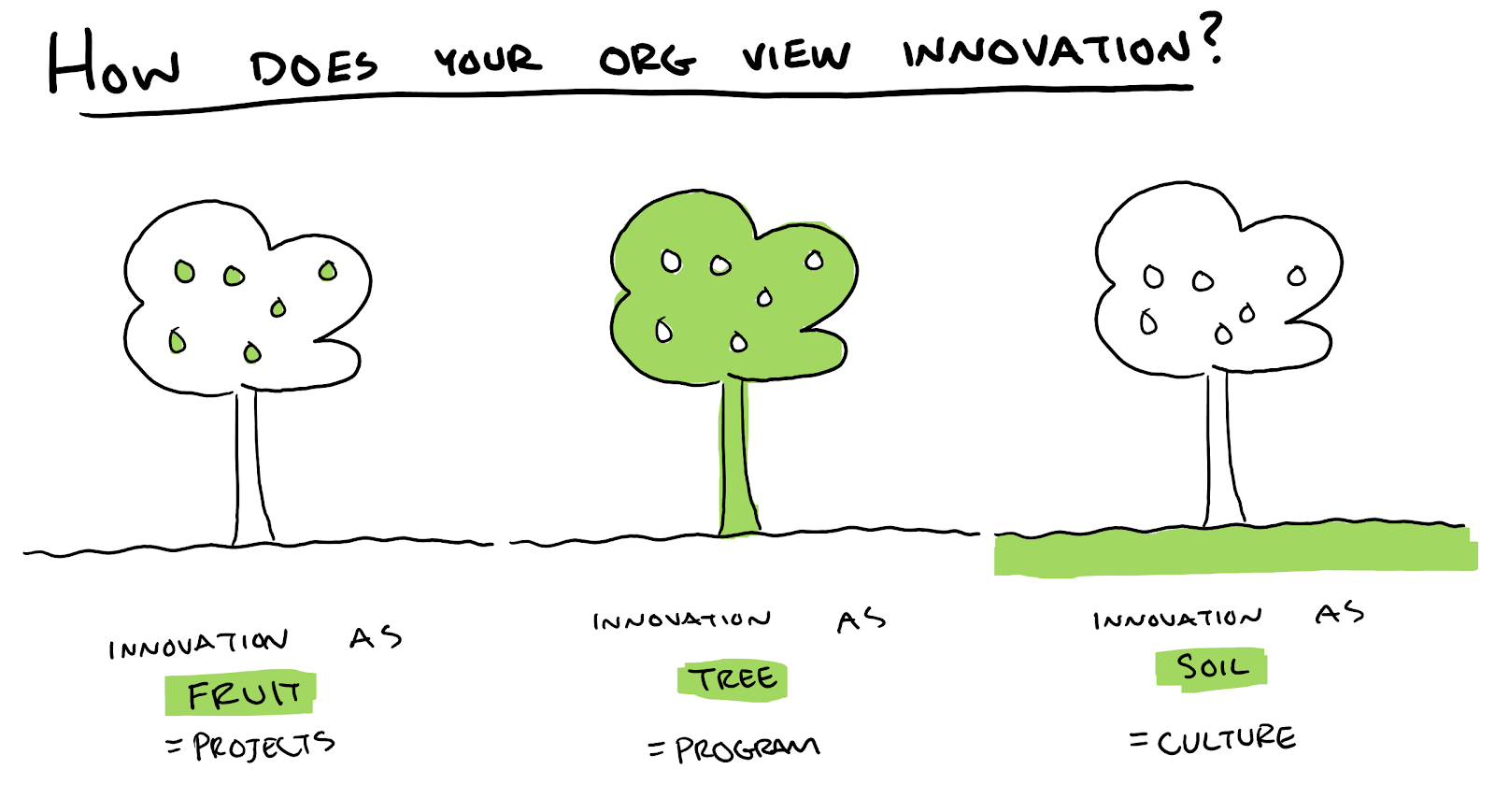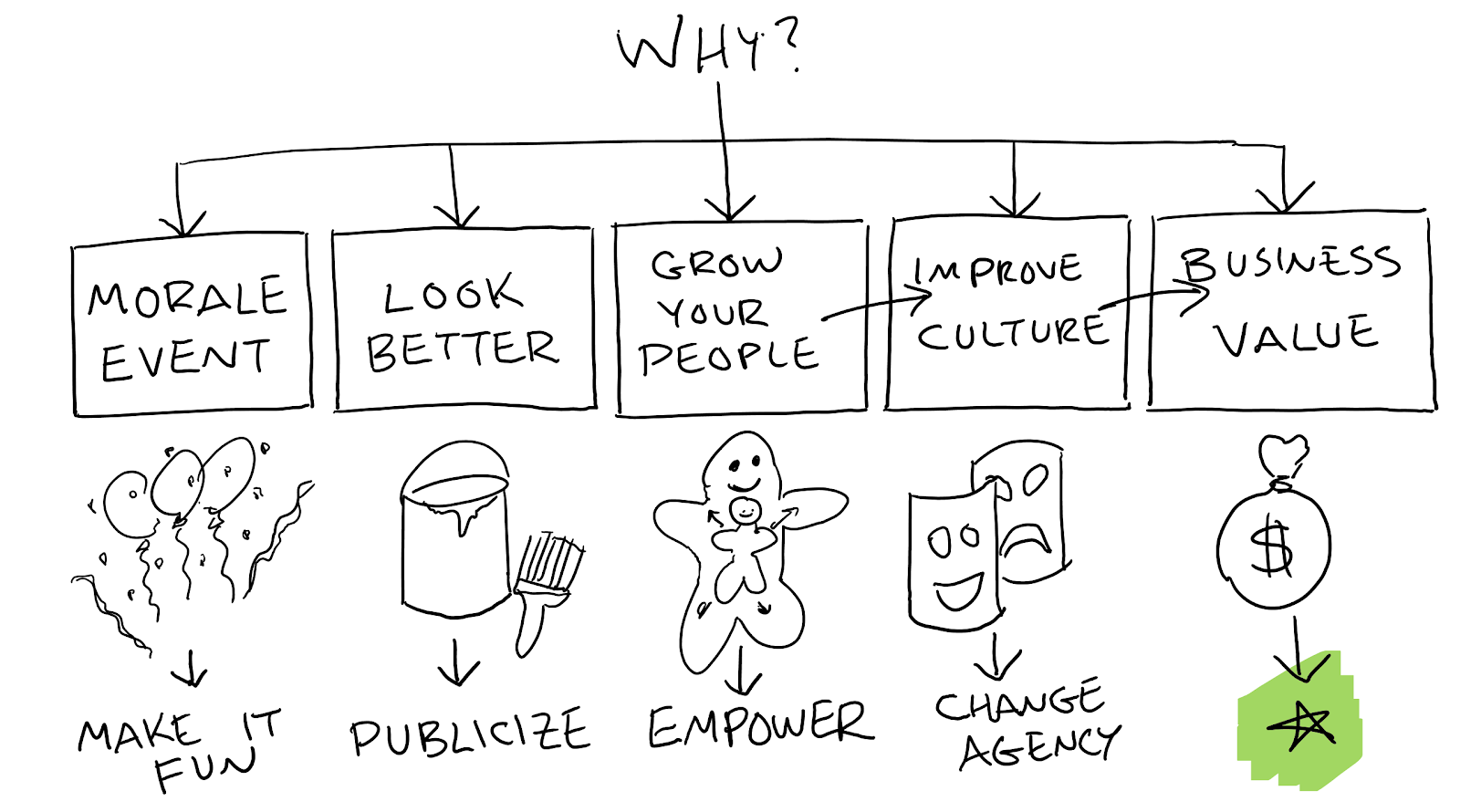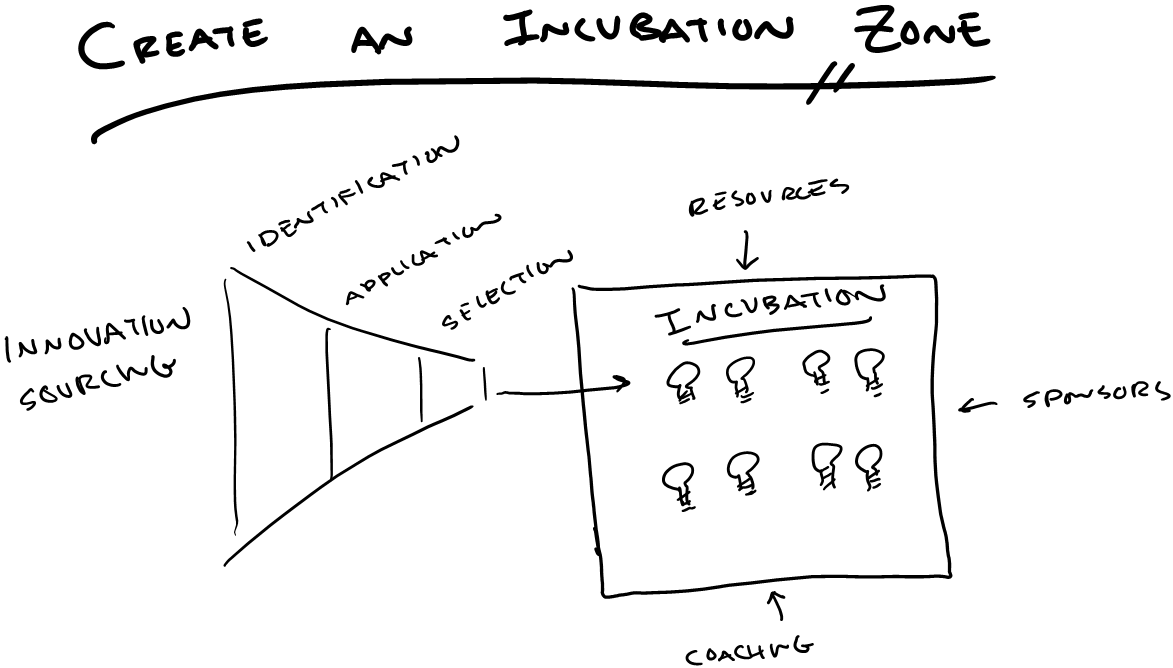Innovation is a tricky word to talk about.
Any time you bring up innovation, everyone’s mind goes in different directions. For your business, innovation might involve ad-hoc, disruptive projects done by teams and leaders with strange titles and fantastical project names. But for others, innovation may be a more holistic, integrated disruption that permeates every layer of their business strategy.
Here’s one thing that 84% of executives can agree on: your organization’s future is dependent on innovation. But if we’re all thinking about innovation differently, how do we define a common framework?
Ed Essey’s talk as recorded during Innov8rs Connect – Business Design & Venture Building. Check the summaries from all talks in the event playbook. Free download via https://innov8rs.co/get-playbook-bdvb/
How Does Your Organization View Innovation?
During our recent Innov8rs Connect – Business Design & Venture Building, Ed Essey, Director Of Incubation And Intrapreneurship At Microsoft Garage, shared his experience in innovating and incubating in large organizations. He likes to break innovation down into three easy-to-digest buckets:
• Fruit innovation
• Tree innovation
• Soil innovation

These three innovation “archetypes” represent the three main ways that organizations view innovation — in terms of framework, culture, and strategy.
Ed suggests that you take a portfolio approach to funding innovation: you need to act like an internal venture firm.
You have to fund many ideas to bear fruit, but you also have to look at your portfolio spread to make sure that you’re investing in the right mixture of projects that make the most sense from a financial standpoint.
1. Fruit Innovation
Some organizations think of innovation as fruit. It’s something that’s readily consumed, and it’s a single, contained project. Usually, these organizations think of innovation solely in terms of innovation projects. So, you may hear, “deliver me this innovation project on this timeline.” Typically, at the end of that timeline, success is immediately measured, and praise or program shuttering occurs.
Ed pointed out one of the major disadvantages to fruit-level innovation, it takes early success or crazy levels of patience. If the results aren’t positive early on, the entire project may get shut down — since results are heavily baked in “right now” KPIs.
2. Tree Innovation
For other organizations, innovation is more like a tree. Instead of focusing solely on the project, these organizations focus on programs that will bear fruit in the long-run. These are typically comprised of multiple project teams working together to innovate new ideas that can scale.
In programs like these, success is measured in more of the long-term, and the idea is to generate multiple fruits with the hopes that you can take one of them to market.
3. Soil Innovation
This is what the Microsoft Garage focuses on. Viewing innovation as soil involves baking innovation into your culture, allowing you to plant multiple trees and bear fruit across all aspects of your organization (i.e., everyone can have an idea, and everyone can have a chance to discuss and proliferate those ideas.)
Here’s the great thing about soil. It grows trees without effort. When your culture supports innovation, you have a long-term, innovation-forward org ecosystem that’s self-sustainable. You can plant multiple seeds, bear plenty of fruit, and use tried-and-true methods to vet each fruit for development.
Again, each of these are valuable. And great projects can come from all three. Ideally, your organization wants to reach the soil stage if you’re interested in long-term innovation and disruption at scale.
The 5 Reasons Why Organizations Innovate
Why does your organization innovate? This may sound like a strange question. After all, the real answer always comes back to business results. But the types of results you’re looking for may dictate your reason for innovating in the first place.
Ed breaks the primary reasons that organizations innovate down into five buckets.
 • To publicize: We’re all guilty of this at one point or another. Innovation looks great. And it can give your company a significant internal and external boost. While it can be easy to think of using innovation for publicity as negative, Essey says it can actually be a great place to start for many organizations.
• To publicize: We’re all guilty of this at one point or another. Innovation looks great. And it can give your company a significant internal and external boost. While it can be easy to think of using innovation for publicity as negative, Essey says it can actually be a great place to start for many organizations.
• To develop talent: Here’s the great thing. Innovation can be a great tool to develop talent. But you have to empower people in the right way. Ed says you have to create programs that give employees the tools to “innovate battles big enough to matter and small enough to win.”
Everyone needs an opportunity to create, but they should have a framework where innovation is logical, structured, and supportive enough to know when to say no and when to say yes.
• To improve culture: When businesses innovate at this layer, they’re making broad, nuanced changes. If you want to transform your culture, you have to give employees change agency. Culture can’t be transformed with policies and notepads. People change culture subtly and over time.
When you empower employees and give everyone in the organization a pipeline to innovation, you create sustainable cultural changes that will inevitably change with your organization — and the global marketplace.
• To deliver business value: This is the end goal. Every “reason” for innovation should end with business value. Sure! Delivering value on innovation is great for your business, but it’s also great for employees. 76% of employees want to make a difference. It’s ingrained in our DNA. If you don’t give them a pathway to business value, your employees will get disenfranchised.
Ideas come from anywhere and everywhere. It’s up to you to develop the systems and policies that enable those ideas and transform the right ones into value generators.
Why You Need Organizational Ambidexterity
Innovation is a balancing act. On the one hand, you have to be able to execute your existing business strategies. On the other hand, you have to create new models that facilitate innovation. Obviously, you can’t let innovation destroy your core business practices. You aren’t a startup with tons of fluidity. You need to keep the pipes flowing.
Usually, we see ambidexterity as two separate lines of business that are intrinsically linked to your existing hierarchy.
In other words, emerging business and existing business exist in two separate units, but they still have a spot in your overall business structure. According to the Harvard Business Review, ambidextrous organizations succeed with innovation 90% of the time.
You need the fear of failure in existing processes, but not new innovations. We’ll talk about the fear of failure in a moment. But it’s important to remember that you have to focus on BOTH your existing processes and new ones sparked by innovation.
And you need the policies in place to facilitate the growth of both, without any intersections that cause disruption.
The Four Main Pathways to Creating Innovation
If you want to create projects that provide business value, you need pathways. Every innovation needs a clear-cut pathway to success. Or, as Ed puts it, “you need to be able to take an idea, have it heard, and move it forward.”
Here’s the problem: you can’t just plug-and-play pathways for a type of idea. They’re all unique.
You can think about innovation in terms of McKinsey’s “Three Horizons” or any other innovation framework model you find best fits your organization. But you need to understand the differences in terms of scope.
Ed broke down four common pathways for innovation.
1. Incubation Zone
Ed brings up incubation zones as one of the leading pathways for developing those long-term, horizon 3 innovations. This involves some hefty cross-collaboration between financial stakeholders and business leaders.
In a nutshell, you break innovation teams up into unique groups with leaders, and then you have a specific zone where all of those leaders can secure funding and vet ideas.
 2. Incremental Improvement Pathway
2. Incremental Improvement Pathway
The key to harboring innovation as a way to spawn incremental improvement in existing practices is to find sponsors. Often times, these incremental improvements can spawn, “not invented here syndrome.” You’re nervous that it’s not the freshest idea on the planet, and you’re similarly worried that some of your competitors utilize the same type of innovation. That’s ok! It’s important to prove value with data and to share that data every step of the way.
Here’s the dirty secret. You’re big. You don’t have to come up with groundbreaking innovations. You just need to have the resources and skills to execute ideas. Don’t think, “that wasn’t invented here…. was it?”; think, “how can we do this better than everyone else.”
3. Internal Changes
If you’re using innovation projects to create internal changes, you need to align three things:
– culture
– processes
– and tools
Change management requires buy-in from sponsors. When you’re dealing with this level of innovation, fit is critical. You can have amazing innovations that simply don’t make sense in your organization. That’s fine! It wasn’t time wasted. Every fruit has value. When you get those shiny fruits that you can’t store in your grocery section, it’s a good idea to have an external network.
4. External Pathways
Alright. So you have this great idea. But it just doesn’t make sense in your organization. What do you do? If you throw it out, you’re creating friction against your innovation culture. Obviously, you can’t keep it, right?
Here’s what Ed recommends: find external receivers. Over 30% of Microsoft’s hackathon projects aren’t used internally. Instead, they’re shipped to nonprofits and external organizations who can really use them.
If you can pair innovation with community programs and non-profit partners, you get to promote the innovation (which drives your culture), and you get to invest in the community (which improves your brand). It’s a win-win.
Why is it So Difficult to Innovate?
As an organization, you have so many innovation advantages. You have resources, rich skill and talent, scale-ready policies and frameworks, world-class leadership, a deep understanding of how to launch, and best-of-breed procedures. So why in the world is it so difficult to innovate?
Organizations are almost always dealing with three hurdles to innovation.
1. Fear
If you go to any startup blog, you’ll hear about how innovation requires bravery and sacrifice. That’s not an option for organizations. You can’t let innovation introduce risk and liability into your business. You just can’t. Fear is good. But that doesn’t mean you have to let fear destroy projects. Here’s what Ed recommends: put it in a box.
In other words, create a safe zone for that incubation innovation, and let everyone know that it’s there, it exists, and that you’re working with it. But contain it. Strip it of risk and liability. Once it’s in that box, you have a chance to really get to know it, see what makes it tick, and figure out if it has actual business value or if the risks are too high.
Make sure that everyone knows that this idea is in a box. Don’t hide it. Contain it. Innovation is risky. But you can’t afford any unnecessary risk. So organizations should find ways to play with innovation in an environment with the right policies and practices. According to a BCG survey, risk aversion and idea filtering are two of the top three barriers preventing businesses from innovating effectively.
2. Low Odds
Lots of ideas fail. So, naturally, innovation may seem wasteful. It’s not that you’re scared of failure. You’re just scared of seeing nothing happen. But, here’s the thing. you’re not a startup. And you’re not a small business. Organizations are far better equipped to launch innovations than your average business.
Ed had some suggestions on how to beat the odds.
• Have a funnel: Good leaders are solution seekers, not solution solvers. You need to have a step-by-step gated funnel that you can pour ideas through. The goal is to create merit-based states that act as an idea meritocracy. All of the ideas flow in; the best ideas are selected and make it to the bottom of the funnel. You should vet ideas based on both customers and stakeholders (or business users for internal innovations).
• Create a selection process: To pick the ideas that are most likely to succeed, you need three things:
– The right people: Ed says you need a “hacker, hipster, and hustler” to get ideas to stage. In other words, you need a good combination of leaders to vet and accelerate ideas.
– The right opportunities: Ideas should be big enough to matter at scale. Sure! Every idea doesn’t have to be a billion-dollar idea. But ideas have to provide benefits relevant to the size of your business.
– The right alignment: Every innovation should be relevant to your organization’s mission and strengths. Again, push ideas to external sources when they don’t fit tightly into your organizational structure. 54% of innovative organizations have difficulty bridging the gap between innovation and larger business goals. Often times, it’s because that innovation simply doesn’t fit into your business.
• Design a method: Obviously, the method you use is huge. You should work with the method that best fits your organization. We could throw around the alphabet soup of methodologies (.e.g, LEAN, design thinking, agile, SCRUM, etc.), but this is definitely something that you should be developing internally based on a plethora of needs, metrics, and talent.
• Leverage your resources: You need to have policies in place that allow anyone, from anywhere in the company to bring an idea to the table. Everyone should have a clear path to funding. If you fail on this part, there’s a good chance innovation gets stalled. If employees feel like there’s nowhere to take those lightbulb moments, they’ll let them pass.
3. Rejection
Recognizing when a project is a real death or false death is half of the battle. In fact, Ed spends a good chunk of his time helping organizations tell the difference between a bump and a mountain.
Ideally, you want to work through all of the ways that an idea can get squashed before you start pushing it through an incubator. If you know what to expect, it will be easier to understand when innovation is no longer viable.
Playbook Innov8rs Connect - Business Design & Venture Building
Get all summaries of 16 sessions from our recent online event Innov8rs Connect Business Design - Venture Building on 12-13 May 2020 in one 90+ pages Playbook.


